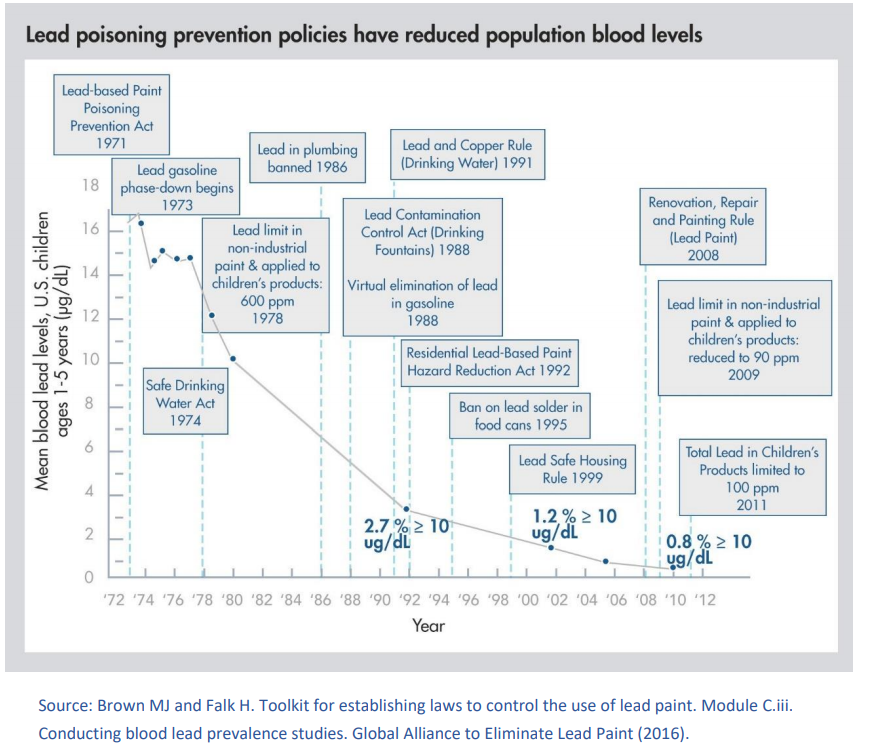
Though the 2015 Flint, Michigan water crisis reminded the nation that lead poisoning remains a relevant health concern, evolving lead poisoning prevention policies have helped to significantly reduce childhood exposure to lead and focus on lead paint removal. Here's a brief look at how lead regulations have impacted childhood blood lead levels over time, and what work remains to be done to protect children from lead today.
Lead Levels Decline as Lead Regulations Expand:
Significant reforms protecting the public from exposure to lead began in earnest in the 1970s, as widespread cases of childhood lead poisoning prompted action. Several government agencies, including the Center for Disease Control (CDC), the Department of Housing and Urban Development (HUD), the Environmental Protection Agency (EPA), and the Occupational Safety and Health Administration (OSHA) began testing populations for lead exposure, and, with increased understanding, lowering the acceptable blood level limits for lead in both children and adults. New guidelines were enacted to both clean up existing lead in the environment and to prevent future lead contamination. Such policies and regulations include:
- The Lead-based Paint Poisoning Prevention Act of 1971.
- The phasing out of leaded gasoline in 1973.
- The Safe Drinking Water Act of 1974.
- Lead banned from use in plumbing in 1986.
As a result of these policies and other laws and regulations, childhood lead levels drastically decreased over time. By 2010, as a result of additional provisions which further limited the total lead allowable in children's products, the mean blood lead levels for U.S. children, ages 1 to 5, had decreased from a high of around 16% (in the 1970s) to less than 1%. For further information on lead remediation in the U.S., including a chart showing the correlation between lead regulations and mean blood lead levels in children over time, click here.
For the CDC's current guidelines surrounding blood lead levels in children, click here.
Addressing Childhood Lead Exposure Today:
Despite this encouraging progress, elevated lead levels in children is an issue that requires ongoing remediation. In places like Flint, and other locations across the country where corroded water systems, lead paint, and other environmental lead exposures remain, specific populations continue to have unsafe blood lead levels. Although there is still work to be done, there exists a will to deal with the problem of childhood lead exposure in the United States. Regulations surrounding water testing in schools and day care centers have contributed to identifying areas of concern. Further, it is part of the government's Healthy People 2020 initiative to prevent lead exposure to young children by the year 2020. With continued effort, regulation, remediation, and increased awareness, such a goal will go a long way toward protecting future generations from the dangers of lead.
ECOBOND® Paint LLC is the nation’s leader in developing and distributing products that improve the protection of human health and safety from the hazards of lead in the home, workplace, and the environment. With over 15 years in patented and proven success, the ECOBOND® family of products have been extensively used in successfully treating lead hazards in over 11,000,000 tons of material while serving over 100,000 customers in the United States and Internationally.
The ECOBOND® Paint family of products now includes Bitrex® a bitter-tasting additive to discourage oral contact! This creates an added safety barrier to further protect children from lead poisoning by reducing the amount of paint chips or dust a child may ingest. Bitrex® is the bitterest substance known and is added to ECOBOND® to reduce accidental ingestion of potentially harmful materials.
